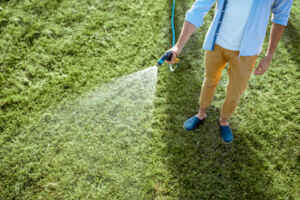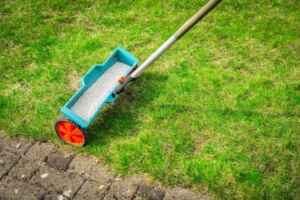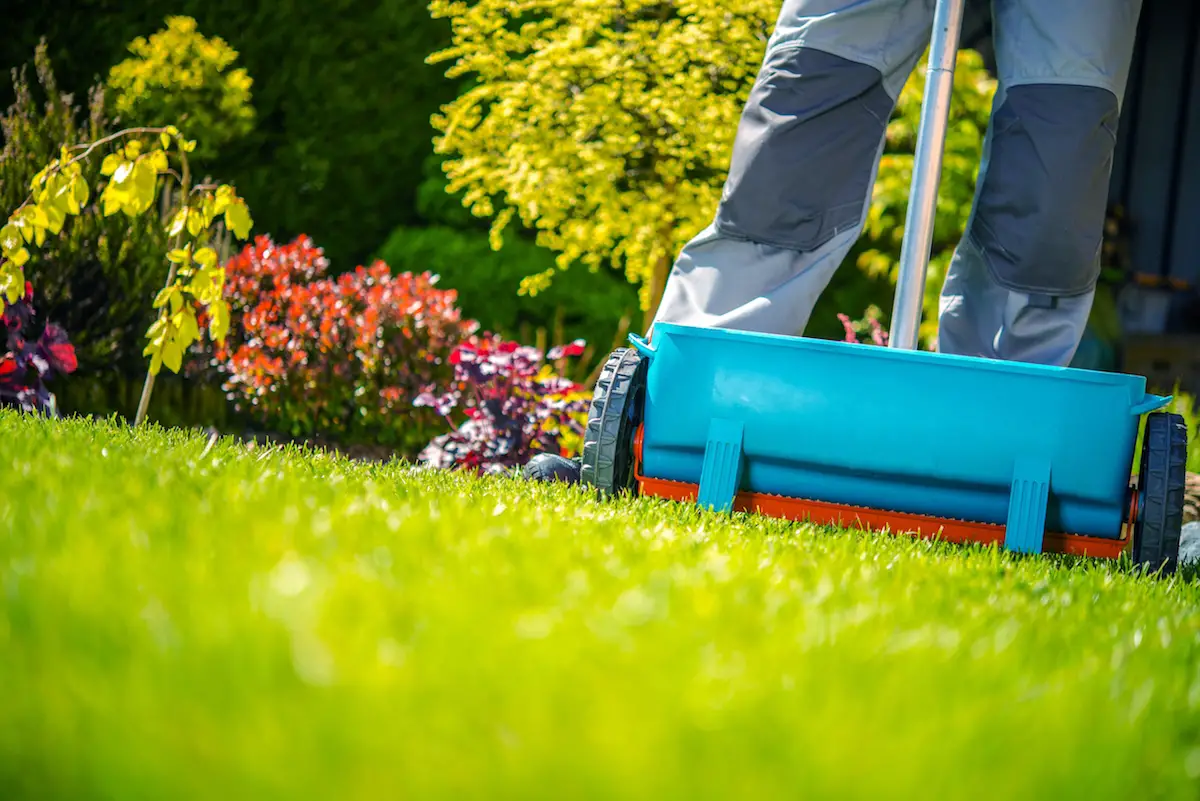The Best Time to Fertilize New Grass
When it comes to your new lawn, it is important to know how to care for it so it can grow and look healthy for years to come. One type of maintenance that can help keep your new lawn looking great is fertilizing, however many find this process intimidating. Timing is an important aspect when it comes to fertilizing, and can be even more so when it comes to fertilizing a new lawn. So, when is the best time to fertilize new grass?
Spring and Fall are the best times to fertilize, as typically this is when the grass grows the most. Also, whenever you first plant your grass, you should fertilize it immediately. Then, you should fertilize it again after six to eight weeks. After that, you should fertilize your grass two or three times a year.
While these times are typically the best for fertilizing new grass, this is not the same for everyone. As there are several factors that can help you determine the best time to fertilize your new lawn. These can include the grass type, time of year, climate, and other factors. For example, if you have cool-season grass like bluegrass or fescue, the best time to fertilize would be in the early fall or late spring. If you have warm-season grass like Bermuda or zoysia, the best time to fertilize would be in the late spring or early summer. By taking all of these aspects into account, you can fertilize your new lawn with confidence and provide it with the care it needs to grow into a lush, beautiful lawn in no time!

When to Start Fertilizing
It’s important to fertilize your new grass so it can grow strong and healthy, but knowing when is an important part of taking care of your new lawn. As a general rule of thumb, whenever you first plant your grass, you should fertilize it immediately. Then, you should fertilize it again after six to eight weeks. After that, you should fertilize your grass two or three times a year. Spring is the best time to fertilize your grass, but you can also do it in early fall. Just make sure you don’t fertilize your grass during the hot summer months, as this can damage the roots. By following these rules, your grass will grow great on your lawn and continue to thrive for several years to come. This is due to the nutrient-rich soil created by fertilizing, something that is important for all lawns, young or old!
How Often You Should Fertilize
To continue the care of your new lawn, you will need to fertilize more than once to keep your grass looking great. As a general rule of thumb, you should fertilize your new lawn two to three times per year. The best times to fertilize are in the spring and fall, as this is when grass typically grows the most.
However, if you live in an area with a warm climate, you may need to fertilize more often, as grass growth can occur year-round. This can be tricky to do however as if the weather is too hot, fertilizing can burn your lawn as a result. It is always best to check with your local nursery or garden center to see what they recommend for fertilizer schedules in your area. They can also help recommend different types of fertilizers to you to make sure that your lawn gets the nutrients that it needs.
How to Fertilize Your Lawn
Now that you know when to fertilize your new lawn, it is time to learn how! When it comes to actually apply the fertilizer, there are a few different ways you can do so. For small lawns, you can simply spread the fertilizer by hand using a small scoop or shovel. If you have a larger lawn, you may want to use a lawn spreader to make the job go faster. Whichever method you choose, be sure to follow the directions on the fertilizer packaging so that you apply the correct amount. Applying too much fertilizer can damage your lawn, so it is important to be precise.
If you have any concerns or worries about the application process, always make sure to reach out to your local nursery for advice and tips on fertilizing your lawn. Of course, there are other things to keep in mind when fertilizing your new lawn as well. Make sure to always follow the directions on the fertilizer product you choose, and never apply more than recommended. Also be sure to water your lawn after applying fertilizer, as this will help it to absorb the nutrients more effectively.
Watering and Mowing
After deciding the best way to distribute fertilizer on your lawn, make sure you apply it evenly throughout your grass. Once you have applied the fertilizer, water your lawn thoroughly to help the nutrients soak in. Watering your lawn after fertilizing can also prevent the burning of your lawn during the warmer months. You should also avoid mowing your lawn for at least 24 hours after fertilizing to give the grass time to absorb the nutrients. By following these simple tips, you can provide proper care to your grass and keep your new lawn looking its best all year long!
It’s important to fertilize your new grass so it can grow strong and healthy. When you first plant your grass, you should fertilize it immediately. Then, you should fertilize it again after six to eight weeks. After that, you should fertilize your grass two or three times a year. Spring is the best time to fertilize your grass, but you can also do it in early fall. Just make sure you don’t fertilize your grass during the hot summer months, as this can damage the roots.

What Kind of Fertilizer to Use
If you want your new grass to be healthy and thrive, then you need to make sure you are fertilizing it correctly. Fertilizing new grass is important because it helps the grass roots to grow strong and develop a deep root system. A strong root system is a key to having healthy grass that can withstand drought and other challenges. The best time to fertilize new grass is in the spring, after the last frost. This will give the grass a chance to establish itself before the hot summer months when the lawn will be under more stress.
Apply a fertilizer that is high in nitrogen, such as 21-0-0 or 32-0-0. You can also use a slow-release fertilizer, which will provide nutrients to the grass over a longer period of time. Apply the fertilizer according to the manufacturer’s instructions. Be sure to water the lawn after fertilizing to help the nutrients soak into the soil. You should fertilize your new grass once every six weeks during the growing season. Stop fertilizing in late fall, before the first frost, so that the grass can go dormant for the winter. By doing this, you can help ensure the long-lasting health of your lawn by providing it with the care it needs to properly grow.
The Benefits of Fertilizing Your New Lawn
Fertilizing your new lawn has many benefits. For one, it helps the grass to grow stronger and healthier. It also helps to prevent weeds from taking over, and it can even improve the color of your grass. Of course, you want to be sure to use the right fertilizer so you don’t damage your lawn. Be sure to ask your local nursery or garden center for advice on what fertilizer to use. They can also help you figure out how often you should fertilize your new lawn.
Fertilizing will also help your lawn grow quicker as well, allowing you to have a beautiful and lush lawn as soon as possible. It also helps to create a deeper root system. This is important for drought tolerance as it allows the grass to collect water that is deeper into the ground. Fertilizing also helps to improve the overall appearance of your lawn by making the grass greener and thicker. Plus, a healthy, well-fertilized lawn is simply more attractive than one that isn’t cared for properly. If you want your new lawn to look its best, make sure you fertilize it as soon as you can and maintain a regular fertilizing and lawn maintenance schedule.

Why You Should Fertilize Your New Lawn
By fertilizing your new lawn, you are helping your grass grow strong and lush. You will also help your lawn last for years to come by providing it with the needed nutrients to grow and survive. This will help it grow a strong root system and be able to protect itself from things like the drought in the future. Watering, mowing, and other maintenance are also needed for a beautiful lawn. However, starting off with fertilizing is a great way to ensure success for your new lawn. This is an important part of lawn maintenance. So, making sure you get the right fertilizer and schedule is also crucial to the success of your lawn. Researching the type of grass you have as well as your local climate can all be great ways to understand the kind of fertilizing schedule your lawn will need. By following the tips above, your lawn is sure to look beautiful in no time and increase your curb appeal!

